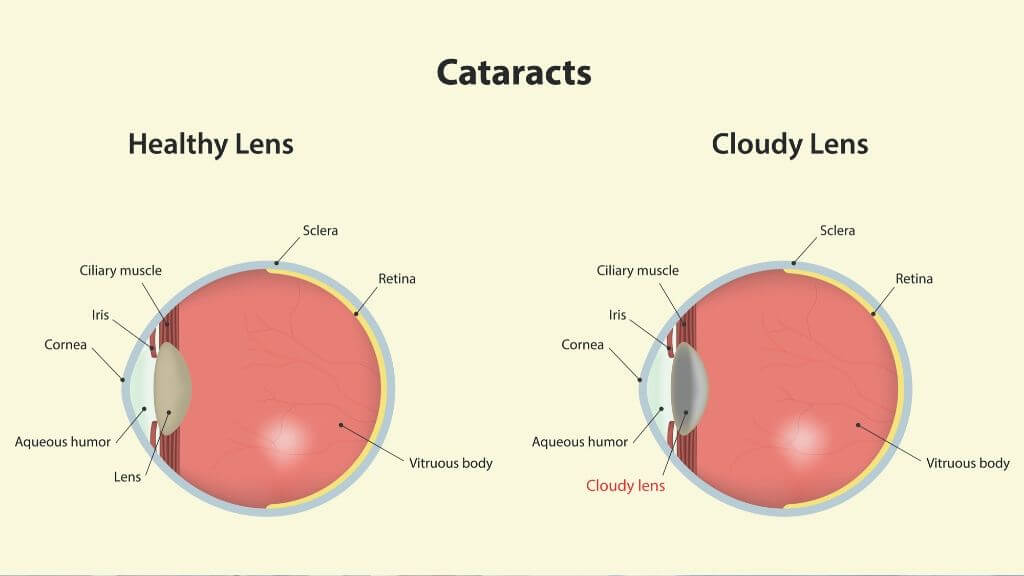Cataracts are cloudy areas around the lens of your eye. These occur more frequently the older you get. It is possible to have cataracts and not know. Over time, they will begin to make your vision blurry and less colorful. You may begin to have trouble reading or doing other activities.
Cataracts are the leading cause of vision loss in people over the age of 40. When caught early, cataracts can be successfully treated.
What Causes Cataracts?
Cataracts occur naturally as you get older. The proteins in the lens begin to break down after the age of 40. They clump together, causing cloudy areas.
There are a number of underlying factors that increase the risk of cataracts.
♦ Smoking
♦ Ultraviolet radiation
♦ Eye trauma
♦ Overproduction of oxidants (volatile oxygen molecules)
♦ Diabetes
♦ Long term use of steroids
♦ Radiation therapy
The risk of cataracts is high for individuals who smoke, drink alcohol excessively, are obese, have high blood pressure, have diabetes, and a family history of cataracts.
Cataracts Symptoms
Cataracts take time to develop, and they appear later in life. The lens of the eye gradually becomes cloudy, blurring vision.

The cloudiness occurs over time, so cataracts are not typically noticed until vision is obviously affected. Long-distance vision is more affected at the beginning of cataract development. The symptoms of cataracts include:
♦ Blurry or cloudy vision
♦ Small spots or dots
♦ Vision worsens when lights are dim
♦ Vision sometimes worsen with bright lights
♦ Colors appear less clear
♦ Glasses need to be changed more frequently
♦ Small patches that blur the field of vision
Cataracts Diagnosis
Your doctor needs to perform a comprehensive eye exam to check for cataracts. An eye chart test is used to check your vision at varying distances. Tonometry is also used to determine the pressure in your eye. A painless puff of air is blown into your eye to flatten the cornea. This allows eye pressure to be effectively measured.
Eye drops may also be used to dilate your pupils. Enlarged pupils make it easier to see the optic nerve and retina at the back of the eye. Your doctor may also test your color perception and sensitivity to glare.
Treatment for Cataracts
Surgery is the only way to get rid of cataracts, but this may not be required right away. After testing, your doctor may prescribe different glasses or contact lenses. You can also use brighter lights at home and wear anti-glare sunglasses.

Using a magnifying glass to read or to look at smaller objects is also advised to improve vision. Once cataracts begin to interfere with your daily activities, surgery will be advised.
Cataracts and Surgery
Cataract surgery is one of the most common types of surgery today. Surgery is an option when you have any of the following:
♦ Having trouble driving
♦ Find it difficult to recognize faces
♦ Unable to perform job tasks
♦ Having trouble reading or watching television
trouble looking after yourself
♦ There are two surgical methods commonly used to treat cataracts.
Phacoemulsification uses ultrasound waves to break the lens apart and remove the pieces. Extracapsular surgery involves making a long incision in the cornea. The pieces are then removed through this incision. An artificial intraocular lens is inserted to replace the natural lens.
Cataract surgery is routine and has a high success rate. Most people are able to return home the same day as the surgery.
Cataracts Diet
The right diet cannot cure or even treat cataracts. The right diet can help prevent cataracts or slow their growth. Oxidative stress damages enzymes and proteins that protect the eye, which increases the risk of cataracts. The right diet can help prevent this.

A diet rich in antioxidants can reduce oxidative stress, strengthening the eye from within. In this way, certain foods can reduce the risk of developing cataracts in the first place.
♦ Antioxidants: Diets full of fresh fruits and vegetables are linked to a reduced risk of cataracts. The phytochemicals in plants are strong antioxidants that protect your eyes. Fruits and vegetables full of vitamins A, C, and E are ideal for preventing cataracts.
♦ Carbohydrates: Studies have found that diets high in carbohydrates are not beneficial for eye health. Individuals with a high carbohydrate intake have a greater risk of developing cataracts as compared to those with low carbohydrate intake.
♦ Omega-3 fatty acids: DHA is one of the most common and essential omega-3 fatty acids. It is a major structural component of the retina. Diets rich in omega-3 fatty acids have a reduced risk of cataracts and other eye conditions. Foods high in omega-3s include fatty fish like tuna and salmon and nuts.
Natural Treatments for Cataracts
Cataracts cannot be cured, but they can be removed surgically. In many cases, vision is not badly impaired, and cataracts can be treated.
♦ Turmeric: Curcumin, the key compound in turmeric, is a powerful antioxidant and anti-inflammatory agent. Its properties have been linked to a reduced risk of developing cataracts by protecting the eyes from damaging processes.
♦ Bilberry extract: This antioxidant has been used to successfully reduce the risk of cataracts. The powerful antioxidant improves eyesight and protects against oxidative damage that causes cataracts.
♦ Drink more water: Hydration is essential to eye health. Toxins can accumulate in your body, which can trigger inflammation and oxidative stress throughout all organs, including the eyes. Staying hydrated keeps cells healthy and detoxifies your body to prevent this damage.
♦ Reduce stress: Stress has been linked to increased risk of several eye problems, including cataracts. You can protect your eyes by reducing stress as much as possible. Exercise, meditation, yoga, and deep breathing are all great ways to reduce stress. This can reverse negative conditions in your body and allow your body to heal naturally.

What Are the Variations of Cataracts?
There are different types of cataracts classified by where and how they develop.
♦ Nuclear cataracts develop in the middle of the lens, causing the nucleus to turn yellow or brown.
♦ Posterior capsular cataracts affect the back of the lens.
♦ Cortical cataracts form around the edge of the nucleus and are wedge-shaped.
♦ Congenital cataracts are present from birth and are less common than age-related cataracts.
♦ Secondary cataracts develop as a result of diseases such as glaucoma or diabetes, or from the use of medications like steroids.
♦ Radiation cataracts can develop after an individual has had cancer therapy.
♦ Traumatic cataracts occur after an eye injury. In this case, it can take years before the cataract develops.
Cataracts Statistics
♦ There are approximately 30.1 million individuals with cataracts in the United States.
♦ More than half of Americans over the age of 80 have cataracts or have had them removed.
♦ The average age for the first diagnosis of cataracts is between 73 and 75.
♦ Half of the people diagnosed between 75 and 85 have lost some vision.
Cataracts and Disability
If cataracts have disrupted your vision to a certain point, it can be classified as a disability. When vision is too poor for you to perform daily functions or work, it becomes more serious. At this stage, surgery is likely needed.
Vision loss cannot be reversed, so surgery may not repair vision if extensive damage was already done. Depending on the severity of the vision loss and the success of surgery, you may not be able to return to work.

Cataracts and Children
Although uncommon, cataracts can be present in children at birth. Congenital cataracts can be caused by different factors and are either unilateral (one eye) or bilateral (both eyes).
One-third of unilateral congenital cataract cases are associated with severe syndromes or diseases, while another third are linked to an inherited trait. The remaining cases do not have a definitive cause. Metabolic diseases, such as diabetes, are more commonly associated with bilateral cataracts.
Some congenital cataracts are small and do not impair vision. Those that do need to be surgically removed. Surgery is typically done before the child is ten weeks old. The longer the cataracts are left in place, the more permanent the damage can be.
Cataracts in children that are not treated can lead to blindness.
What Is the Long-Term Outlook?
Cataracts develop as part of the aging process. Certain factors can increase your risk of developing them sooner. Cataracts can interfere with daily activities and lead to blindness if untreated. Surgical removal of cataracts is a routine procedure and is highly effective.
Choosing a diet and healthy lifestyle choices can enhance eye health and reduce the problems and complications associated with cataracts.






